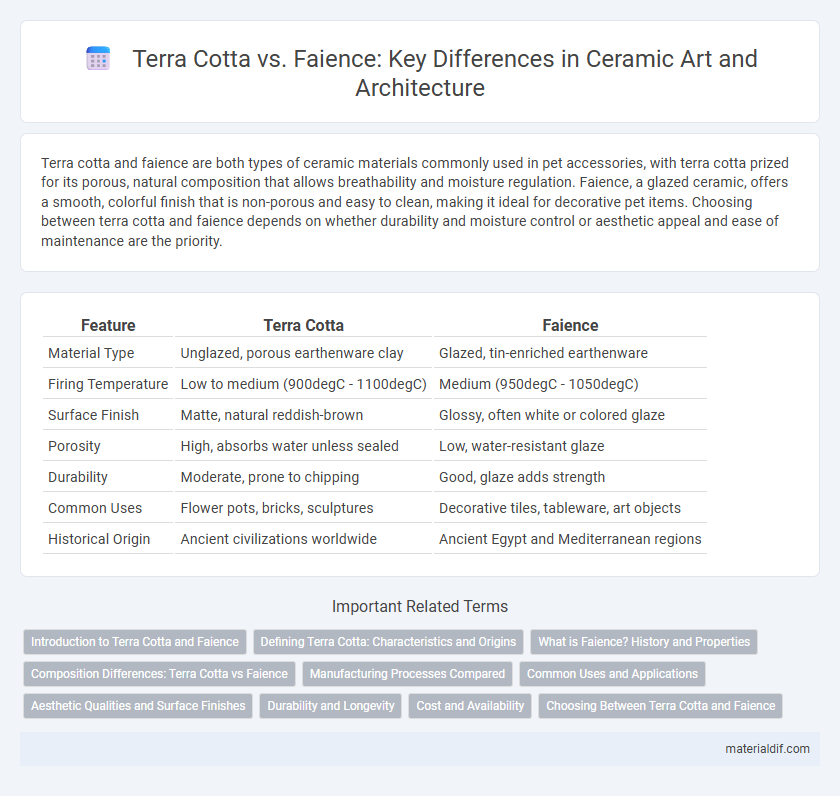Terra cotta and faience are both types of ceramic materials commonly used in pet accessories, with terra cotta prized for its porous, natural composition that allows breathability and moisture regulation. Faience, a glazed ceramic, offers a smooth, colorful finish that is non-porous and easy to clean, making it ideal for decorative pet items. Choosing between terra cotta and faience depends on whether durability and moisture control or aesthetic appeal and ease of maintenance are the priority.
Table of Comparison
| Feature | Terra Cotta | Faience |
|---|---|---|
| Material Type | Unglazed, porous earthenware clay | Glazed, tin-enriched earthenware |
| Firing Temperature | Low to medium (900degC - 1100degC) | Medium (950degC - 1050degC) |
| Surface Finish | Matte, natural reddish-brown | Glossy, often white or colored glaze |
| Porosity | High, absorbs water unless sealed | Low, water-resistant glaze |
| Durability | Moderate, prone to chipping | Good, glaze adds strength |
| Common Uses | Flower pots, bricks, sculptures | Decorative tiles, tableware, art objects |
| Historical Origin | Ancient civilizations worldwide | Ancient Egypt and Mediterranean regions |
Introduction to Terra Cotta and Faience
Terra cotta, a porous, unglazed clay ceramic, is widely used for pottery, sculpture, and architectural elements due to its durability and earthy appearance. Faience, contrastingly, refers to a glazed non-clay ceramic, known for its bright, glossy finish and intricate decorative patterns often found in ancient Egyptian and European artifacts. Both materials highlight distinct firing techniques and surface treatments that influence their historical and functional applications.
Defining Terra Cotta: Characteristics and Origins
Terra cotta is a porous, reddish-brown earthenware clay known for its durability and natural iron content that gives it a distinct warm hue. Originating from ancient civilizations, this ceramic material is primarily unglazed, making it ideal for sculptures, architectural elements, and pottery. Its versatility and earthy aesthetic have made terra cotta a staple in both functional and artistic ceramic applications worldwide.
What is Faience? History and Properties
Faience is a type of glazed ceramic ware known for its bright, opaque colors and glossy surface, originating in ancient Egypt and widely produced in the Mediterranean region. Its composition typically involves a porous earthenware body coated with a tin-based glaze that creates a white, opaque surface ideal for vibrant decoration. This ceramic contrasts with terracotta, which is unglazed and more porous, making faience more suitable for decorative and ceremonial objects due to its durability and vivid appearance.
Composition Differences: Terra Cotta vs Faience
Terra cotta is composed primarily of natural clay with high iron content, resulting in its characteristic reddish-brown color after firing, while faience is made from ground quartz mixed with small amounts of alkali and lime, creating a glass-like, glazed surface. Terra cotta is typically porous and unglazed, offering a matte finish suitable for structural and sculptural applications, whereas faience achieves a glossy, colorful appearance through its vitreous glaze. The mineral compositions of both materials fundamentally influence their texture, durability, and aesthetic qualities, distinguishing terracotta's earthy, robust nature from faience's decorative, glossy appeal.
Manufacturing Processes Compared
Terra cotta is produced by shaping natural clay and firing it at relatively low temperatures between 1,000degC and 1,150degC, resulting in a porous, reddish-brown ceramic due to iron content. Faience manufacturing involves coating a porous earthenware body with a tin-based glaze and firing at higher temperatures of 1,050degC to 1,150degC, producing a glossy, opaque surface with vibrant colors. The key manufacturing difference lies in faience's addition of a vitreous glaze layer, enhancing aesthetic appeal and water resistance compared to the unglazed, matte finish of terra cotta.
Common Uses and Applications
Terra cotta is predominantly used in architectural elements such as roofing tiles, flower pots, and sculptures due to its durability and porous nature. Faience, characterized by its glazed finish, is commonly applied in decorative objects, jewelry, and historical ceramics, especially in ancient Egyptian and Mediterranean art. The porous, unglazed surface of terra cotta contrasts with the glossy, colorful appearance of faience, influencing their specific functional and aesthetic applications.
Aesthetic Qualities and Surface Finishes
Terra cotta exhibits a warm, earthy tone with a matte or slightly porous surface that enhances its rustic and natural aesthetic, often emphasized by its rich reddish-brown color. Faience, on the other hand, is known for its vibrant, glossy glaze that provides a smooth, reflective finish, often decorated with intricate patterns and bright colors that create a striking visual contrast. The surface finish of terra cotta highlights texture and organic imperfections, whereas faience emphasizes brilliance and decorative detail.
Durability and Longevity
Terra cotta exhibits superior durability and longevity due to its dense, fired clay composition, which resists weathering and cracking over time. Faience, a glazed non-clay ceramic, offers vivid colors but tends to be more brittle and less resistant to mechanical stress and environmental wear. Consequently, terra cotta is preferred for structural and outdoor applications where enduring strength is essential.
Cost and Availability
Terra cotta is generally more affordable and widely available due to its natural clay composition and simple firing process, making it a cost-effective choice for both artisans and manufacturers. Faience, a glazed non-clay ceramic, often incurs higher costs because of its intricate production techniques and the use of specialized glazes, which can limit its availability. The choice between terra cotta and faience largely depends on budget constraints and accessibility to specific ceramic materials and craftsmanship.
Choosing Between Terra Cotta and Faience
Choosing between terra cotta and faience depends on the desired aesthetic and functional properties; terra cotta offers a porous, earthy texture ideal for rustic pottery and architectural elements, while faience provides a glazed, vibrant finish suited for decorative and fine art ceramics. Terra cotta is cost-effective and durable for outdoor use, whereas faience requires more delicate handling due to its glazed surface. Understanding the differences in firing temperature and material composition helps artisans select the best ceramic type for their specific project needs.
Terra Cotta vs Faience Infographic

 materialdif.com
materialdif.com